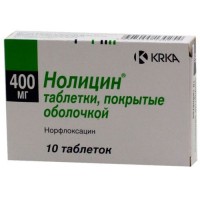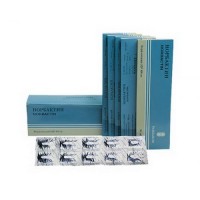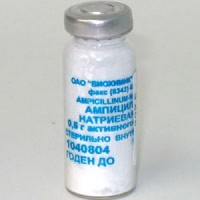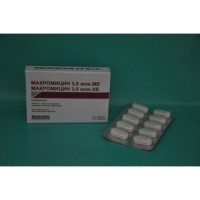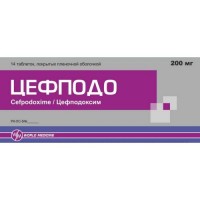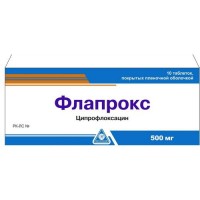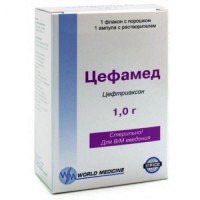Zitmak 200 mg / 5 ml 15 ml powder for suspension in (vial) with a solvent
- $20.40
The instruction for medical use
of ЗИТМАК® 200 medicine
the Trade name
ЗИТМАК® 200
International unlicensed
name Azithromycin Dosage Form Powder for preparation of suspension for intake of 200 mg / 5
- azithromycin a dihydrate of 628.93 mg, 1257.86 mg are equivalent to ml complete with the water purified Structure active agent 600 mg and 1200 mg of azithromycin respectively.
excipients: sugar (icing sugar), sodium phosphate anhydrous, hydroxypropyl cellulose (Klutsel EXF), xanthane gum, banana fragrance, cherry fragrance.
The description
Powder of white color with a smell of banana and cherry.
After cultivation the water purified forms uniform suspension of yellow-white color with a smell of banana and cherry.
Pharmacotherapeutic group
Antibacterial drugs for system use. Macroleads, linkozamida and streptogramina. Macroleads. Azithromycin.
The ATX J01FA10 code
the Pharmacological
Pharmacokinetics Azithromycin properties is quickly soaked up at oral administration that is caused by its stability in acidic environment and lipophilicity. After single dose 37% of azithromycin are inside soaked up, and the peak of concentration in plasma (0.41µg/мл) is registered in 2-3 hours. The volume of distribution of Vd is about 31 l/kg. Azithromycin well gets into airways, bodies and fabrics of an urogenital path, a prostate, into skin and soft tissues, reaching from 1 to 9 µg/мл depending on a type of fabric. High concentration in fabrics (is 50 times higher, than concentration in plasma) and the long half-life period is caused by low linking of azithromycin with proteins of blood plasma and also its ability to get into eukaryotic cells and to concentrate in the environment with a low rn, a surrounding lysosome. The ability of azithromycin to collect in lysosomes is especially important for elimination of intracellular activators. Phagocytes deliver azithromycin to places of localization of an infection where it is released in the course of phagocytosis. But, despite high concentration in phagocytes, azithromycin does not affect their function. Therapeutic concentration remains 5-7 days after intake of the last dose. At intake of azithromycin perhaps tranzitorny increase in activity of liver enzymes. Removal of a half of a dose from blood plasma is reflected on reduction of a half of a dose in fabrics within 2-4 days. After administration of drug in the range from 8 till 24 o'clock elimination half-life makes 14-20 hours, and after administration of drug in the range from 24 till 72 o'clock – 41 hour that ZITMAK of 1 times a day allows to accept. The main way of removal – with bile. About 50% are removed in not changed look, other 50% - in the form of 10 inactive metabolites. About 6% of the accepted dose are removed by kidneys.
The pharmacodynamics
Active agent of the drug ZITMAK® - azithromycin is an antibiotic of a broad spectrum of activity, the first representative of new subgroup of makrolidny antibiotics – azaleads. Possesses bacteriostatic action, but during creation in the center of inflammation of high concentrations renders bactericidal effect. Azithromycin suppresses synthesis of protein in sensitive microorganisms, showing activity concerning the majority of strains of gram-positive, gram-negative, anaerobic, intracellular and other microorganisms: Mycoplasma pneumoniae, Haemophilus ducreyi, Moraxella catarrhalis, Propionibacterium acnes, Gardnerella vaginalis, Actinomyces species, Bordetella pertussis, Borrelia burgdorferi, Mobiluncus species, Haemophilus influenzae, Streptococcus pyogenes, Haemophilus parainfluenzae, Streptococcus pneumoniae, Legionella pneumophila, Streptococcus agalactiae, Neisseria meningitides, Streptococcus viridans, Neisseria gonorrhoeae, Streptococcus group C, F, G, Helicobacter pylori, Peptococcus species, Campylobacter jejuni, Peptostreptococcus, Pasteurella multocida, Fusobacterium necrophorum, Pasteurella haemolytica, Clostridium perfringens, Brucella melitensis, Bacteroides bivius, Bordetella parapertussis, Chlamydia trachomatis, Vibrio cholerae, Chlamydia pneumoniae, Vibrio parahaemolyticus, Ureaplasma urealyticum, Plesiomonas shigelloides, Listeria monocytogenes, Staphylococcus epidermidis, Staphylococcus aureus * (*эритромицин – a sensitive strain), Escherichia coli, Bacteroides fragilis, Salmonella enteritidis, Bacteroides oralis, Salmonella typhi, Clostridium difficile, Shigella sonnei, Eubacterium lentum, Yersinia enterocolitica, Fusobacterium nucleatum, Acinetobacter calcoaceticus, Aeromonas hydrophilia.
Indications
- upper respiratory tract infections (bacterial pharyngitis / tonsillitis, sinusitis, average otitis)
- lower respiratory tract infections (bacterial bronchitis, interstitial and alveolar pneumonia, exacerbation of chronic bronchitis)
- infections of skin and soft tissues (the chronic migrating erythema - an initial stage of a disease of Lyme, an ugly face, impetigo, secondary pyodermatoses)
- the diseases of a stomach and a duodenum associated with Helicobacter pylori
- an infection of an urogenital path (gonorrheal and not gonorrheal urethritis and/or a cervicitis)
accept the Route of administration and doses ЗИТМАК® in the form of oral suspension 1 time a day in 1 hour prior to or in 2 hours after a meal by means of a measured spoon.
Infections of upper and lower airways, skin and soft tissues (except for the chronic migrating erythema)
the Course dose makes 30 mg/kg.
Two schemes of treatment are applied:
1) 10 mg/kg of body weight once a day within 3 days
2) 10 mg/kg of body weight in the first day and on 5 mg/kg of body weight from the 2nd to the 5th day
to Children with body weight more than 14 kg and the adult are recommended prescribing of ЗИТМАК® 200 suspension of mg / 5 to ml
Body weight
ЗИТМАК® powder for preparation of oral suspension of 200 mg / 5 by ml
of 15-25
kg 5 ml (200 mg)
of 25-34
kg 7.5 ml (300 mg)
of 35-44
kg 10 ml (400 mg)
≥ 45
kg 12.5 ml (500 mg)
the Chronic migrating erythema
the Course dose of drug make 60 mg/kg: once on 20 mg/kg –
in the 1st day and on 10 mg/kg - in the subsequent, from 2 to 5 days.
Diseases of a stomach and a 12-perstny gut, associated with Helicobacter pylori:
The dosage of azithromycin makes 20 mg/kg of body weight in combination with anti-secretory means and other medicines once a day (in complex therapy).
In case the dose of drug was passed, it needs to be accepted at once, and then to accept the subsequent doses at an interval of the 24th hour.
Infections of an urogenital path:
Not gonococcal urethritis / cervicitis – 1 g once.
Gonococcal and also complicated, it is long the proceeding urethritis/cervicitis - on 1 g three times at an interval of 7 days (1-7-14). Course dose of 3 g.
The way of preparation of suspension
For contents of one bottle is added by 9 ml or 15 ml of the water purified and mix before receiving uniform suspension of 15 ml or 30 ml respectively.
Before reception the bottle contents are carefully shaken up before receiving uniform suspension. Directly after intake of suspension to the child allow to drink several drinks of liquid to wash away and swallow the remained amount of suspension in an oral cavity.
Side effects
Often (& gt, 1/100, & lt, 1/10)
- nausea, vomiting, diarrhea, an abdominal pain
not often (& gt, 1/1000, & lt, 1/100)
- a liquid chair, a meteorism, a digestive disturbance, loss of appetite
Seldom (& gt, 1/1000, & lt, 1/100)
- a headache, dizziness, drowsiness, spasms
- thrombocytopenia
- aggression, excitement, concern, nervousness, insomnia
- paresthesias and an asthenia
- a hearing disorder, deafness and sonitus
- heartbeat, arrhythmia with ventricular tachycardia, lengthening
of an interval of QT
- discoloration of language, a constipation, pseudomembranous colitis
- tranzitorny rise in level of aminotransferases of a liver, bilirubin,
cholestatic jaundice, hepatitis
- reactions of hypersensitivity (reddening, skin rash, an itching,
a small tortoiseshell, a Quincke's disease, photosensitivity),
a multiformny erythema, Stephens-Johnson's syndrome and a toxic
epidermal necrolysis
- an arthralgia
Very seldom (& gt, 1/10000, & lt, 1/1000)
- interstitial nephrite, an acute renal failure
- fatigue, convulsions
- change of taste and sense of smell
- an arthralgia
- vaginita, candidiasis, superinfections
- an acute anaphylaxis including hypostasis (in rare instances leading to
death)
Contraindications
- hypersensitivity to makrolidny antibiotics
- heavy abnormal liver functions and kidneys
- pregnancy and the period of a lactation
Medicinal interactions
Antacids substantially reduce absorption ЗИТМАКА® of suspension therefore the drug should be taken in one hour prior to or in two hours after intake of these drugs. Makrolidny antibiotics interact with digoxin, cyclosporine, astemizoly, triazolamy, midazolam or alfentanily. It is recommended to make careful observation at a concomitant use of these drugs.
Azithromycin does not connect R-450 cytochrome and therefore does not interact with theophylline, terfenadiny, warfarin, carbamazepine, Methylprednisolonum and Cimetidinum.
At simultaneous use of azithromycin and anticoagulants of indirect action perhaps bleedings. Therefore at the same time it is necessary to carry out control of a prothrombin time.
Rifabutin: joint use of azithromycin and a rifabutin did not change their plasma concentration. However at the same time the neutropenia was observed.
Special
indications ЗИТМАК® 200 of mg / 5 the ml is intended for use for children with body weight over 14 kg and also at adult patients.
Duration of use of drug should not exceed the terms specified in the instruction.
It is necessary to take with care the drug in abnormal liver functions and kidneys, to the patient having disturbances or predisposed to arrhythmias and lengthening of an interval of QT.
Pregnancy and a lactation
Safety of use ЗИТМАК® for pregnant women is not established therefore it is not recommended to appoint it during pregnancy.
Azithromycin gets into breast milk therefore the women nursing should not appoint ЗИТМАК®.
Features of influence of medicine on ability to run the vehicle or potentially dangerous mechanisms
Considering side effects of medicine it is necessary to be careful at control of motor transport and potentially dangerous mechanisms.
Overdose
of Data concerning overdose are insufficient.
Symptoms: nausea, vomiting, diarrhea, temporary hearing loss
Treatment: to wash out a stomach and to appoint symptomatic treatment
the Form of release and packing
On 16.0 g (for preparation of 15 ml of suspension of 200 mg / 5 in ml) and 29.0 g (for preparation of 30 ml of suspension of 200 mg / 5 ml) powder place in the plastic bottles of white color corked by the screwing-up polyethylene cover with control of the first opening.
On a bottle paste the label.
Plastic and a plastic bottle with the water purified 9 ml (for preparation of 15 ml of suspension of 200 mg / 5 ml) or 15 ml (for preparation of 30 ml of suspension of 200 mg / 5 ml) together with the instruction for medical use in the state and Russian languages place 1 bottle complete with a measured spoon in a cardboard pack.
To Store storage conditions at a temperature not over 25 ºС, in the dry, protected from light place.
To store out of children's reach!
A period of storage
3 years
not to apply after the storage expiration
the Period of storage of the prepared suspension
of 14 days
Prescription status
According to the prescription
the Producer / Packer
of JSC Nobel Almatinskaya Pharmatsevticheskaya Fabrika
Republic of Kazakhstan, Almaty, Shevchenko St. 162 E.
Owner of the registration certificate
of JSC Nobel Almatinskaya Pharmatsevticheskaya Fabrika
Republic of Kazakhstan Almaty, Shevchenko St. 162 E.
The address of the organization accepting in the territory of the Republic of Kazakhstan claims from consumers on quality of products (goods) of JSC Nobel Almatinskaya Pharmatsevticheskaya Fabrika Republic of Kazakhstan, Almaty, Shevchenko St. 162 E. Phone number: (+7 727) 399-50-50Номер fax: (+7 727) 399-60-60
To Develop the e-mail address of nobel@nobel.kz
of ЗИТМАК® 200 medicine
the Trade name
ЗИТМАК® 200
International unlicensed
name Azithromycin Dosage Form Powder for preparation of suspension for intake of 200 mg / 5
- azithromycin a dihydrate of 628.93 mg, 1257.86 mg are equivalent to ml complete with the water purified Structure active agent 600 mg and 1200 mg of azithromycin respectively.
excipients: sugar (icing sugar), sodium phosphate anhydrous, hydroxypropyl cellulose (Klutsel EXF), xanthane gum, banana fragrance, cherry fragrance.
The description
Powder of white color with a smell of banana and cherry.
After cultivation the water purified forms uniform suspension of yellow-white color with a smell of banana and cherry.
Pharmacotherapeutic group
Antibacterial drugs for system use. Macroleads, linkozamida and streptogramina. Macroleads. Azithromycin.
The ATX J01FA10 code
the Pharmacological
Pharmacokinetics Azithromycin properties is quickly soaked up at oral administration that is caused by its stability in acidic environment and lipophilicity. After single dose 37% of azithromycin are inside soaked up, and the peak of concentration in plasma (0.41µg/мл) is registered in 2-3 hours. The volume of distribution of Vd is about 31 l/kg. Azithromycin well gets into airways, bodies and fabrics of an urogenital path, a prostate, into skin and soft tissues, reaching from 1 to 9 µg/мл depending on a type of fabric. High concentration in fabrics (is 50 times higher, than concentration in plasma) and the long half-life period is caused by low linking of azithromycin with proteins of blood plasma and also its ability to get into eukaryotic cells and to concentrate in the environment with a low rn, a surrounding lysosome. The ability of azithromycin to collect in lysosomes is especially important for elimination of intracellular activators. Phagocytes deliver azithromycin to places of localization of an infection where it is released in the course of phagocytosis. But, despite high concentration in phagocytes, azithromycin does not affect their function. Therapeutic concentration remains 5-7 days after intake of the last dose. At intake of azithromycin perhaps tranzitorny increase in activity of liver enzymes. Removal of a half of a dose from blood plasma is reflected on reduction of a half of a dose in fabrics within 2-4 days. After administration of drug in the range from 8 till 24 o'clock elimination half-life makes 14-20 hours, and after administration of drug in the range from 24 till 72 o'clock – 41 hour that ZITMAK of 1 times a day allows to accept. The main way of removal – with bile. About 50% are removed in not changed look, other 50% - in the form of 10 inactive metabolites. About 6% of the accepted dose are removed by kidneys.
The pharmacodynamics
Active agent of the drug ZITMAK® - azithromycin is an antibiotic of a broad spectrum of activity, the first representative of new subgroup of makrolidny antibiotics – azaleads. Possesses bacteriostatic action, but during creation in the center of inflammation of high concentrations renders bactericidal effect. Azithromycin suppresses synthesis of protein in sensitive microorganisms, showing activity concerning the majority of strains of gram-positive, gram-negative, anaerobic, intracellular and other microorganisms: Mycoplasma pneumoniae, Haemophilus ducreyi, Moraxella catarrhalis, Propionibacterium acnes, Gardnerella vaginalis, Actinomyces species, Bordetella pertussis, Borrelia burgdorferi, Mobiluncus species, Haemophilus influenzae, Streptococcus pyogenes, Haemophilus parainfluenzae, Streptococcus pneumoniae, Legionella pneumophila, Streptococcus agalactiae, Neisseria meningitides, Streptococcus viridans, Neisseria gonorrhoeae, Streptococcus group C, F, G, Helicobacter pylori, Peptococcus species, Campylobacter jejuni, Peptostreptococcus, Pasteurella multocida, Fusobacterium necrophorum, Pasteurella haemolytica, Clostridium perfringens, Brucella melitensis, Bacteroides bivius, Bordetella parapertussis, Chlamydia trachomatis, Vibrio cholerae, Chlamydia pneumoniae, Vibrio parahaemolyticus, Ureaplasma urealyticum, Plesiomonas shigelloides, Listeria monocytogenes, Staphylococcus epidermidis, Staphylococcus aureus * (*эритромицин – a sensitive strain), Escherichia coli, Bacteroides fragilis, Salmonella enteritidis, Bacteroides oralis, Salmonella typhi, Clostridium difficile, Shigella sonnei, Eubacterium lentum, Yersinia enterocolitica, Fusobacterium nucleatum, Acinetobacter calcoaceticus, Aeromonas hydrophilia.
Indications
- upper respiratory tract infections (bacterial pharyngitis / tonsillitis, sinusitis, average otitis)
- lower respiratory tract infections (bacterial bronchitis, interstitial and alveolar pneumonia, exacerbation of chronic bronchitis)
- infections of skin and soft tissues (the chronic migrating erythema - an initial stage of a disease of Lyme, an ugly face, impetigo, secondary pyodermatoses)
- the diseases of a stomach and a duodenum associated with Helicobacter pylori
- an infection of an urogenital path (gonorrheal and not gonorrheal urethritis and/or a cervicitis)
accept the Route of administration and doses ЗИТМАК® in the form of oral suspension 1 time a day in 1 hour prior to or in 2 hours after a meal by means of a measured spoon.
Infections of upper and lower airways, skin and soft tissues (except for the chronic migrating erythema)
the Course dose makes 30 mg/kg.
Two schemes of treatment are applied:
1) 10 mg/kg of body weight once a day within 3 days
2) 10 mg/kg of body weight in the first day and on 5 mg/kg of body weight from the 2nd to the 5th day
to Children with body weight more than 14 kg and the adult are recommended prescribing of ЗИТМАК® 200 suspension of mg / 5 to ml
Body weight
ЗИТМАК® powder for preparation of oral suspension of 200 mg / 5 by ml
of 15-25
kg 5 ml (200 mg)
of 25-34
kg 7.5 ml (300 mg)
of 35-44
kg 10 ml (400 mg)
≥ 45
kg 12.5 ml (500 mg)
the Chronic migrating erythema
the Course dose of drug make 60 mg/kg: once on 20 mg/kg –
in the 1st day and on 10 mg/kg - in the subsequent, from 2 to 5 days.
Diseases of a stomach and a 12-perstny gut, associated with Helicobacter pylori:
The dosage of azithromycin makes 20 mg/kg of body weight in combination with anti-secretory means and other medicines once a day (in complex therapy).
In case the dose of drug was passed, it needs to be accepted at once, and then to accept the subsequent doses at an interval of the 24th hour.
Infections of an urogenital path:
Not gonococcal urethritis / cervicitis – 1 g once.
Gonococcal and also complicated, it is long the proceeding urethritis/cervicitis - on 1 g three times at an interval of 7 days (1-7-14). Course dose of 3 g.
The way of preparation of suspension
For contents of one bottle is added by 9 ml or 15 ml of the water purified and mix before receiving uniform suspension of 15 ml or 30 ml respectively.
Before reception the bottle contents are carefully shaken up before receiving uniform suspension. Directly after intake of suspension to the child allow to drink several drinks of liquid to wash away and swallow the remained amount of suspension in an oral cavity.
Side effects
Often (& gt, 1/100, & lt, 1/10)
- nausea, vomiting, diarrhea, an abdominal pain
not often (& gt, 1/1000, & lt, 1/100)
- a liquid chair, a meteorism, a digestive disturbance, loss of appetite
Seldom (& gt, 1/1000, & lt, 1/100)
- a headache, dizziness, drowsiness, spasms
- thrombocytopenia
- aggression, excitement, concern, nervousness, insomnia
- paresthesias and an asthenia
- a hearing disorder, deafness and sonitus
- heartbeat, arrhythmia with ventricular tachycardia, lengthening
of an interval of QT
- discoloration of language, a constipation, pseudomembranous colitis
- tranzitorny rise in level of aminotransferases of a liver, bilirubin,
cholestatic jaundice, hepatitis
- reactions of hypersensitivity (reddening, skin rash, an itching,
a small tortoiseshell, a Quincke's disease, photosensitivity),
a multiformny erythema, Stephens-Johnson's syndrome and a toxic
epidermal necrolysis
- an arthralgia
Very seldom (& gt, 1/10000, & lt, 1/1000)
- interstitial nephrite, an acute renal failure
- fatigue, convulsions
- change of taste and sense of smell
- an arthralgia
- vaginita, candidiasis, superinfections
- an acute anaphylaxis including hypostasis (in rare instances leading to
death)
Contraindications
- hypersensitivity to makrolidny antibiotics
- heavy abnormal liver functions and kidneys
- pregnancy and the period of a lactation
Medicinal interactions
Antacids substantially reduce absorption ЗИТМАКА® of suspension therefore the drug should be taken in one hour prior to or in two hours after intake of these drugs. Makrolidny antibiotics interact with digoxin, cyclosporine, astemizoly, triazolamy, midazolam or alfentanily. It is recommended to make careful observation at a concomitant use of these drugs.
Azithromycin does not connect R-450 cytochrome and therefore does not interact with theophylline, terfenadiny, warfarin, carbamazepine, Methylprednisolonum and Cimetidinum.
At simultaneous use of azithromycin and anticoagulants of indirect action perhaps bleedings. Therefore at the same time it is necessary to carry out control of a prothrombin time.
Rifabutin: joint use of azithromycin and a rifabutin did not change their plasma concentration. However at the same time the neutropenia was observed.
Special
indications ЗИТМАК® 200 of mg / 5 the ml is intended for use for children with body weight over 14 kg and also at adult patients.
Duration of use of drug should not exceed the terms specified in the instruction.
It is necessary to take with care the drug in abnormal liver functions and kidneys, to the patient having disturbances or predisposed to arrhythmias and lengthening of an interval of QT.
Pregnancy and a lactation
Safety of use ЗИТМАК® for pregnant women is not established therefore it is not recommended to appoint it during pregnancy.
Azithromycin gets into breast milk therefore the women nursing should not appoint ЗИТМАК®.
Features of influence of medicine on ability to run the vehicle or potentially dangerous mechanisms
Considering side effects of medicine it is necessary to be careful at control of motor transport and potentially dangerous mechanisms.
Overdose
of Data concerning overdose are insufficient.
Symptoms: nausea, vomiting, diarrhea, temporary hearing loss
Treatment: to wash out a stomach and to appoint symptomatic treatment
the Form of release and packing
On 16.0 g (for preparation of 15 ml of suspension of 200 mg / 5 in ml) and 29.0 g (for preparation of 30 ml of suspension of 200 mg / 5 ml) powder place in the plastic bottles of white color corked by the screwing-up polyethylene cover with control of the first opening.
On a bottle paste the label.
Plastic and a plastic bottle with the water purified 9 ml (for preparation of 15 ml of suspension of 200 mg / 5 ml) or 15 ml (for preparation of 30 ml of suspension of 200 mg / 5 ml) together with the instruction for medical use in the state and Russian languages place 1 bottle complete with a measured spoon in a cardboard pack.
To Store storage conditions at a temperature not over 25 ºС, in the dry, protected from light place.
To store out of children's reach!
A period of storage
3 years
not to apply after the storage expiration
the Period of storage of the prepared suspension
of 14 days
Prescription status
According to the prescription
the Producer / Packer
of JSC Nobel Almatinskaya Pharmatsevticheskaya Fabrika
Republic of Kazakhstan, Almaty, Shevchenko St. 162 E.
Owner of the registration certificate
of JSC Nobel Almatinskaya Pharmatsevticheskaya Fabrika
Republic of Kazakhstan Almaty, Shevchenko St. 162 E.
The address of the organization accepting in the territory of the Republic of Kazakhstan claims from consumers on quality of products (goods) of JSC Nobel Almatinskaya Pharmatsevticheskaya Fabrika Republic of Kazakhstan, Almaty, Shevchenko St. 162 E. Phone number: (+7 727) 399-50-50Номер fax: (+7 727) 399-60-60
To Develop the e-mail address of nobel@nobel.kz

